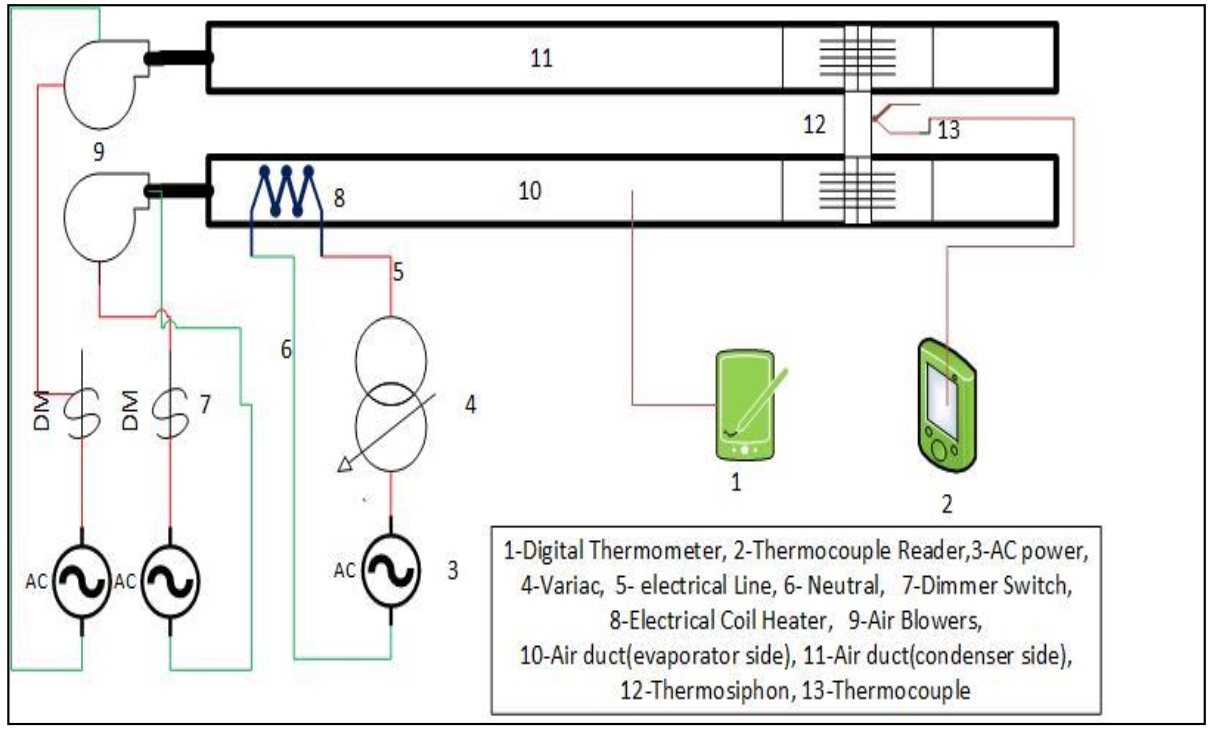Experimental Study of the Wickless Heat Pipe Heat Exchanger by Using Nano Fluid
DOI:
https://doi.org/10.51173/jt.v5i4.1278Keywords:
Nanofluid, Wickless Heat Pipe, Heat Exchanger, Working Fluid, EffectivenessAbstract
The use of wickless heat pipe heat exchangers has been improving a wide range of thermal applications such as solar water heaters. Therefore, more scientific research needs to be conducted to improve its performance. In the present study, a wickless heat pipe heat exchanger test rig has been designed and fabricated to investigate the effect of different parameters on its performance. Two different heat pipe working fluids have been used namely pure water and water with nanoparticles (Al2O3) using different fluid volume ratios (20%,40%,60%,80%, and 100%). The concentrations of the nanoparticles in water range between 1.3 and 7 % wt. For the heat exchanger, various inlet hot air temperatures (50, 55, and 60 oC) have been tested at the hot side (heat pipe evaporator) whereas the inlet temperature of the cold side (heat pipe condenser) has been maintained at 20 oC. The effect of airflow Reynolds number has also been examined with a range of 2583-20664. Results showed that the best heat exchanger effectiveness is achieved at a Reynolds number of 10332 and nanoparticles concentration of 7% wt. Also, the use of nanoparticles reduced the thermal resistance in the heat pipe due to the significant reduction in its surface temperature compared to that of pure water.
Downloads
References
M. Može, A. Nemanič, and P. Poredoš, “Experimental and numerical heat transfer analysis of heat-pipe-based CPU coolers and performance optimization methodology,” Appl Therm Eng, vol. 179, Oct. 2020, doi: 10.1016/j.applthermaleng.2020.115720.
W. Srimuang and P. Amatachaya, “A review of the applications of heat pipe heat exchangers for heat recovery,” Renewable and Sustainable Energy Reviews, vol. 16, no. 6. pp. 4303–4315, Aug. 2012. doi: 10.1016/j.rser.2012.03.030.
Y. Naresh and C. Balaji, “Experimental investigations of heat transfer from an internally finned two phase closed thermosyphon,” Appl Therm Eng, vol. 112, pp. 1658–1666, 2017, doi: 10.1016/j.applthermaleng.2016.10.084.
M. G. Mousa, “Effect of nanofluid concentration on the performance of circular heat pipe,” Ain Shams Engineering Journal, vol. 2, no. 1, pp. 63–69, 2011, doi: 10.1016/j.asej.2011.03.003.
M. H. Buschmann and U. Franzke, “Improvement of thermosyphon performance by employing nanofluid,” International Journal of Refrigeration, vol. 40, pp. 416–428, 2014, doi: 10.1016/j.ijrefrig.2013.11.022.
L. G. Asirvatham, S. Wongwises, and J. Babu, “Heat transfer performance of a glass thermosyphon using graphene-acetone nanofluid,” J Heat Transfer, vol. 137, no. 11, pp. 1–9, 2015, doi: 10.1115/1.4030479.
M. M. Sarafraz, O. Pourmehran, B. Yang, and M. Arjomandi, “Assessment of the thermal performance of a thermosyphon heat pipe using zirconia-acetone nanofluids,” Renew Energy, vol. 136, pp. 884–895, 2019, doi: 10.1016/j.renene.2019.01.035.
Y. Fulpagare, D. Y. Tsai, and C. C. Wang, “Performance of two-phase loop thermosiphon with graphene nanofluid,” Appl Therm Eng, vol. 200, no. October 2021, p. 117714, 2022, doi: 10.1016/j.applthermaleng.2021.117714.
M. Narcy, S. Lips, and V. Sartre, “Experimental investigation of a confined flat two-phase thermosyphon for electronics cooling,” Exp Therm Fluid Sci, vol. 96, no. September 2017, pp. 516–529, 2018, doi: 10.1016/j.expthermflusci.2018.01.018.
S. L. Abreu and S. Colle, “An experimental study of two-phase closed thermosyphons for compact solar domestic hot-water systems,” Solar Energy, vol. 76, no. 1–3, pp. 141–145, 2004, doi: 10.1016/j.solener.2003.02.001.
H. M. S. Hussein, H. H. El-Ghetany, and S. A. Nada, “Performance of wickless heat pipe flat plate solar collectors having different pipes cross sections geometries and filling ratios,” Energy Convers Manag, vol. 47, no. 11–12, pp. 1539–1549, 2006, doi: 10.1016/j.enconman.2005.08.009.
K. Ochsner, “Carbon dioxide heat pipe in conjunction with a ground source heat pump (GSHP),” Appl Therm Eng, vol. 28, no. 16, pp. 2077–2082, 2008, doi: 10.1016/j.applthermaleng.2008.04.023.
A. Bhatia, “HVAC - How to Size and Design Ducts,” Continuing Education and Development, Inc., no. 877, p. 89, 2001.
B. Kundu and P. K. Das, “Performance and optimum design analysis of convective fin arrays attached to flat and curved primary surfaces,” International Journal of Refrigeration, vol. 32, no. 3, pp. 430–443, 2009, doi: 10.1016/j.ijrefrig.2008.08.012.
X. Yang, J. Guo, B. Yang, H. Cheng, P. Wei, and Y. L. He, “Design of non-uniformly distributed annular fins for a shell-and-tube thermal energy storage unit,” Appl Energy, vol. 279, no. July, p. 115772, 2020, doi: 10.1016/j.apenergy.2020.115772.
O. Raad, “The improvement of the solar air heater duct by wired ribs utilization,” Karbala International Journal of Modern Science, vol. 5, no. 3, 2019, doi: 10.33640/2405-609X.1163.
A. Ozsoy and R. Yildirim, “Prevention of icing with ground source heat pipe: A theoretical analysis for Turkey’s climatic conditions,” Cold Reg Sci Technol, vol. 125, pp. 65–71, 2016, doi: 10.1016/j.coldregions.2016.02.003.
S. I. Haider, Y. K. Joshi, and W. Nakayama, “A natural circulation model of the closed loop, two-phase thermosyphon for electronics cooling,” J Heat Transfer, vol. 124, no. 5, pp. 881–890, 2002, doi: 10.1115/1.1482404.
Y. A. Çengel, “Heat Exchangers,” in Heat Transfer Engineering, 2009, pp. 609–662.
Fadhl, Bandar. Modelling of the thermal behaviour of a two-phase closed thermosyphon. Diss. Brunel University London, 2016, http://bura.brunel.ac.uk/handle/2438/12871.

Downloads
Published
How to Cite
Issue
Section
License
Copyright (c) 2023 Osamah Raad Skheel, Nabil J. Yasin, Audai Hussain Al-abbas, Sumair Ahmed Soomro

This work is licensed under a Creative Commons Attribution 4.0 International License.
















